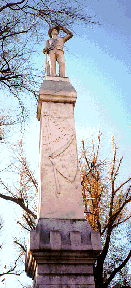|
If a civilization can be decoded in its monuments -- those stone-cold reminders of things held sacred - what are we to make of the South and its statuary? Southerners have built some pretty strange pigeon roosts over the years. We've raised shrines to industry (Vulcan, lording over Birmingham's steel mills in that skimpy loincloth), to crops (Crystal City, Texas, grows so much spinach that folks there erected a statue of Popeye), even to insects that wiped out crops (Enterprise, Ala., grateful to the boll weevil for weaning it from cotton, built the only known monument to a pest).
But there's no question what we've memorialized the most. In countless cemeteries and courthouse squares, the Rebel infantryman is as familiar a part of the landscape as a magnolia tree. Outnumbered in war, the Confederacy has never been outnumbered on the battlefields of stone.
No civilization has built more monuments to defeat than the South has with its Confederate memorials. It's a bit odd when you think about it. If the University of Georgia football team had a dog of a season, do you think boosters would drive around with bumper stickers that said "Lest We Forget"? (Well, maybe if they wanted the coach's scalp...) Yet generations of Southerners thought it sacrilegious to forget, and they paid many thousands of dollars to build reminders.
While a few Confederate memorials have appeared in recent years, most were dedicated around the turn of the century - more than 300 from 1900 to 1912 alone, according to Stephen Davis, a Civil War historian in Atlanta who wrote his doctoral thesis at Emory University on the Confederate image.
The first memorials tended to be simple graveyard expressions of grief. There's no dashing soldier atop Atlanta's first monument, an 1873 obelisk in Oakland Cemetery. (A more wrenching picture of grief sits a few feet away: A granite lion, lanced between the ribs, grimaces as it lays its head on a Rebel flag to die. The 1894 sculpture is all the more affecting because it marks the common grave of hundreds of unknown soldiers.) The most famous Confederate monuments are the flamboyant ones - Nathan Bedford Forrest leading a cavalry charge through downtown Memphis, Robert E. Lee and Stonewall Jackson astride steeds on pedestals along Monument Avenue in Richmond.
But far more typical are the hundreds of soldiers who stand on eternal picket duty, leaning on rifles, usually atop a column whose base carries some verse extolling their sacrifice. Some monuments go so far as to argue the justness of their cause to future generations. One in Greenville, S.C., carries this prideful quatrain: The world shall yet decide, In truth's clear, far-off light, That the soldiers who wore the gray -- And fought with Lee -- were in the right.
Which just goes to show that attitudes, like inscriptions, erode.
"Seventy years ago," Davis says, "those stone soldiers were seen as the original agrarian rebels. Now they represent a racist society unworthy of our adulation. I fully expect someone to go to Stone Mountain before the Olympics and blast the nose off General Lee."
Perhaps. Or perhaps Southerners will come to understand that different eras make different monuments, and leave it at that. There's a new one in Birmingham that's as arresting in its way as that dying lion in Oakland Cemetery. It shows German shepherds leaping and snarling. Your muscles flinch just walking near them, their cold, bronze teeth are so menacing. You can almost hear them growl.
The monument commemorates Bull Connor's 1963 attack on civil rights workers in the place where it happened, Kelly Ingram Park. It's a powerful example of a new kind of monument beginning to appear across the region, a monument to a cause that's as much a part of the South as the Confederacy ever was.
This time, it's a monument to victory.
| 
The South specializes in erecting monuments to lost causes such as this vigilant Confederate States of America soldier.
|




